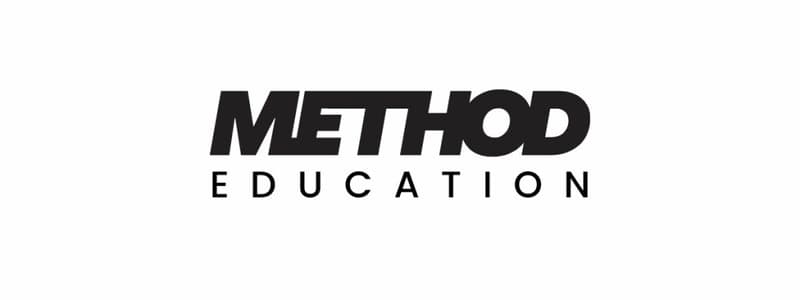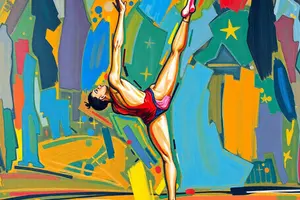Podcast
Questions and Answers
According to the CrossFit hierarchy, what foundational element must be established before optimizing competency in external object control?
According to the CrossFit hierarchy, what foundational element must be established before optimizing competency in external object control?
- Body control (correct)
- Nutrition
- Sport-specific application
- Cardiovascular efficiency
In the context of CrossFit Gymnastics, what does the term 'strict' refer to?
In the context of CrossFit Gymnastics, what does the term 'strict' refer to?
- Movement performed absent of a kip, relying on muscle control and strength. (correct)
- Muscles that do work even during transitional movement.
- A position used to create stability with strong midline contraction.
- A dynamic movement from a lower plane to a higher plane.
Why does mastering strict movements reduce the possibility of injury?
Why does mastering strict movements reduce the possibility of injury?
- Because they quickly build muscle mass, protecting the joints.
- Because they eliminate the need for active tissue engagement.
- Because strict movements allow for a greater range of motion.
- Because strict movements promote proper form and strength development first. (correct)
What is the primary purpose of achieving a 'hollow' position in CrossFit Gymnastics?
What is the primary purpose of achieving a 'hollow' position in CrossFit Gymnastics?
What principle should guide the learning of gymnastic movements to maximize benefit and minimize risk?
What principle should guide the learning of gymnastic movements to maximize benefit and minimize risk?
Why is strength considered imperative for proper form in gymnastics?
Why is strength considered imperative for proper form in gymnastics?
Which progression aligns with the recommended approach for introducing new gymnastic skills?
Which progression aligns with the recommended approach for introducing new gymnastic skills?
An athlete is having difficulty achieving the proper position in a static gymnastics hold. What should the coach assess FIRST, according to the principles of skill progression?
An athlete is having difficulty achieving the proper position in a static gymnastics hold. What should the coach assess FIRST, according to the principles of skill progression?
A coach is designing a gymnastics training program. How should the coach prioritize the use of apparatus to maximize safety and skill development?
A coach is designing a gymnastics training program. How should the coach prioritize the use of apparatus to maximize safety and skill development?
According to the principle of mechanics, consistency, then intensity, what is the role of a trainer?
According to the principle of mechanics, consistency, then intensity, what is the role of a trainer?
Which of the following is the MOST important consideration when deciding whether to introduce kipping movements to an athlete?
Which of the following is the MOST important consideration when deciding whether to introduce kipping movements to an athlete?
What is the primary reason for spotting an athlete during training?
What is the primary reason for spotting an athlete during training?
What should a coach actively look for while spotting an athlete, besides verbal cues?
What should a coach actively look for while spotting an athlete, besides verbal cues?
Why is it essential to prevent injuries during training?
Why is it essential to prevent injuries during training?
In what scenarios is spotting most effective according to the text?
In what scenarios is spotting most effective according to the text?
In CrossFit, gymnastics is defined as movements performed without external load; which of the following is also considered gymnastics?
In CrossFit, gymnastics is defined as movements performed without external load; which of the following is also considered gymnastics?
Why is gymnastics considered a foundational modality in CrossFit?
Why is gymnastics considered a foundational modality in CrossFit?
Besides body-weight movements, what equipment does CrossFit typically use to implement gymnastics training?
Besides body-weight movements, what equipment does CrossFit typically use to implement gymnastics training?
How does gymnastics training contribute to the ten components of fitness, according to CrossFit?
How does gymnastics training contribute to the ten components of fitness, according to CrossFit?
Within the CrossFit 'pyramid' or Theoretical Hierarchy of Development of an athlete, where does gymnastics fall?
Within the CrossFit 'pyramid' or Theoretical Hierarchy of Development of an athlete, where does gymnastics fall?
Flashcards
The Core (Gymnastics)
The Core (Gymnastics)
Musculature including glutes, traps, front, back, and sides of the torso (excluding extremities).
Form
Form
The correct way to perform a movement, focusing on perfection.
Static Apparatus
Static Apparatus
Stable equipment that does not move, such as the floor or bars.
Dynamic Apparatus
Dynamic Apparatus
Signup and view all the flashcards
Mobility
Mobility
Signup and view all the flashcards
Performance Hierarchy
Performance Hierarchy
Signup and view all the flashcards
Gymnastics (in CrossFit)
Gymnastics (in CrossFit)
Signup and view all the flashcards
Active Tissue
Active Tissue
Signup and view all the flashcards
Hollow Position
Hollow Position
Signup and view all the flashcards
Strict Movement
Strict Movement
Signup and view all the flashcards
CrossFit Gymnastics
CrossFit Gymnastics
Signup and view all the flashcards
Gymnastics Equipment
Gymnastics Equipment
Signup and view all the flashcards
Benefits of Gymnastics
Benefits of Gymnastics
Signup and view all the flashcards
Neurological Benefits
Neurological Benefits
Signup and view all the flashcards
CrossFit Modalities
CrossFit Modalities
Signup and view all the flashcards
Kipping
Kipping
Signup and view all the flashcards
Order of Progression
Order of Progression
Signup and view all the flashcards
Spotting
Spotting
Signup and view all the flashcards
Why Spot?
Why Spot?
Signup and view all the flashcards
Spotting Indicators
Spotting Indicators
Signup and view all the flashcards
Study Notes
Types of Gymnastics
- Artistic gymnastics as seen at the Olympics include four women's events: vault, uneven bars, beam, and floor.
- Men's artistic gymnastics includes six events: vault, high bar, pommels, rings, parallel bars, and floor.
- Acrobatic gymnastics is another genre, similar to Cirque du Soleil, including trapeze, straps, ribbons, balancing acts and trampolines.
- Rhythmic gymnastics uses items like ribbons, batons, balls, and hoops.
- Stunt work in movies and live shows is influenced by gymnastics movements.
Brief History
- Gymnastics dates back to antiquity as Greeks and Romans used gymnastics training to prepare their military forces for combat.
- Gymnastics helped soldiers master skills like mounting and dismounting horses and were also used for entertainment.
- Modern gymnastics appeared in the 18th century when two physical educators created apparatus like the high bar and parallel bars
- They were originally fashioned from a ladder with the rungs removed, and a pommel was turned sideways, then the handles were removed to create vault apparatus.
- Men's gymnastics was accepted into the modern Olympic Games in 1896.
- Women were welcomed in 1928.
- The U.S. Navy adopted gymnastics in 1942 to make naval aviators fearless and to give them better spatial awareness.
- In 2005, Greg Glassman reintroduced a Navy guide to gymnastics and tumbling, used by the 101st Airborne Division of the U.S. Army to develop agility, balance, confidence and strength in soldiers.
CrossFit Gymnastics
- Body-weight movements are considered gymnastics such as air squats, push-ups, pull-ups, etc.
- Skills from gymnastics are applied to workouts.
- The gymnastics label applies to any exercise in which you move your body through a range of motion (ROM) or extended range of motion (EROM) without an external load.
- Isometric holds are also considered gymnastics.
- Short parallel bars ("parallettes”), the floor, still rings, pull-up bars, dip bars, and climbing ropes are used to implement gymnastics training.
Why Do We Do It?
- Gymnastics are foundational to CrossFit and improves fitness.
- They assist in developing accuracy, agility, balance, coordination, cardiovascular endurance, flexibility, power, speed, strength, and stamina.
- Gymnastics training produces incredible strength gains without external loads and are essential to an athlete's development alongside weightlifting and metabolic-conditioning.
- Body control is more important than weight training or sport and the development of movement requires static apparatus before dynamic apparatus.
- Strict movement should come before adding momentum to the movement
- Mechanics and consistency should come before intensity
- Kipping movement allows for higher power output, which is directly related to intensity. Kipping can be troublesome for athletes without control.
Gymnastics Definitions
- Gymnastics are physical exercises used to develop and display strength, balance, and agility.
- Gymnastics is the art or practice of such exercise.
- Includes climbing, yoga, calisthenics, and dance, for example
Gymnastics Terminology
- Active Tissue: Muscles that work even during transitional movement.
- Hollow: A position used to create stability, characterized by strong midline contraction with active tissue from toes to fingers.
- Strict: Movement absent a kip. The athlete relies on muscle control and strength to complete the movement.
- Kip: A dynamic movement from a lower plane to a higher plane.
- Load: The forces created while body weight is in motion.
- Core: Musculature that ranges from the top of the glutes up to the traps, not including the extremities.
- Form: The manner of doing a movement correctly while striving for perfection.
- Static Apparatus: Stable and does not move (floor and bars).
- Dynamic Apparatus: Unstable and moves (rings).
- Skill Set: Training for form and strength before going for time.
- Mobility: Movement around a joint.
- Active Flexibility: Contracting opposing muscles to stretch or hold a position.
- Passive Flexibility: Stretching a muscle that does not require contraction of opposing muscles.
- ROM: Range of motion.
- EROM: Extended range of motion.
- Spotting: Giving assistance to an athlete if needed as part of a progression or in order to prevent injury.
Spotting
- Valuable tool that can be useful for athletes who might struggle and should prevent injuries
- In a class setting, there are obvious challenges, but it is effective in a one-on-one setting.
- Is not just assisting, coach must be on guard for athlete and apparatus.
- Lack of active tissue or muscle fatigue are important clues of a greater need or end the movement altogether. Other times they can be completely unrelated due to kinesthetic awareness.
- Is the athlete connected to the equipment safely, straps on the rings are properly threaded and not slipping or frayed?
- Study and practice spotting.
Gymnastics Movements
- Grip is very important to improve
- Common grips in gymnastics and CrossFit are friction and crushing grips.
- Train with thumbs around the bar and around the rings so there is an increased grip strength and safety.
- Hanging from apparatus or frequently picking things up develops strength.
- Phenomenal resource for grip-strength development is Ironmind.com.
- Without specialized tools, various wrist push-ups, assorted barbell wrist curls for the extensors and flexors of the forearms, and tennis-ball squeezes are ways to improve grip and wrist strength.
Movement and Injury Considerations
- The shoulder joint has impressive range of motion in many different planes, but it also has a significant amount of laxity.
- This often results in instability issues such as rotator-cuff impingements, subluxations, and dislocations.
- Stability is most likely reduced because of mobility.
- The shoulder joint is frequently injured because of its anatomical design, lack of strength and endurance in the shoulder muscles.
- The rotator-cuff muscles play a vital role in maintaining the correct orientation of the head of the humerus.
- Shoulders are typically injured in three ways: falling, traction injuries, and SLAP tears
- Traction injuries occur when the arm is pulled suddenly from the socket.
- SLAP tear is common in baseball pitchers and can be prevented from happening.
- Control prevents the shoulder from rotating too far into external rotation and the legs must be under control.
- Tears are more common as athletes get older because tissue is not as soft, spongy, and pliable. Rehab from a surgical repair can be lengthy.
Studying That Suits You
Use AI to generate personalized quizzes and flashcards to suit your learning preferences.




